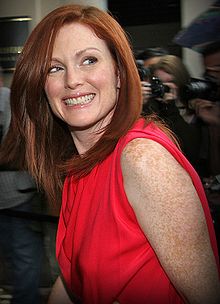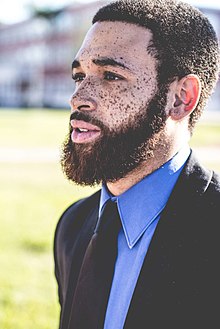Freckle
![]()
The title of this article is ambiguous. For other meanings, see Freckles (disambiguation).
Freckles or ephelides (Ancient Greek ἔφηλις ephelis, plural ephelides from ἐπί epi, German 'at' and ἥλιος hēlios, German 'sun', also summer spots, also lentigines (aestivae), in Austria also Gugerschecken/Gugaschecken or Guckerschecken, in Switzerland also Märzen- or Laubflecken) are small yellowish and brownish spots on the skin, which occur especially in people with blond and reddish hair and very fair complexions.
These are pigment deposits that occur primarily in skin exposed to sunlight, usually in the summer. In some people they fade in winter or disappear completely.
Freckles are caused by melanocytes that produce increased melanin (hyperpigmentation). This melanin is stored in the surrounding keratinocytes for some time. In contrast to liver spots, freckles do not cause a local proliferation of melanocytes.
Freckles are a normal variant. They are probably caused by congenital gene variants in the melanocortin-1 receptor, which is also held responsible for skin and hair colour. As mainly fair skin and hair types are affected, there is often a special medical recommendation for sun protection and sun avoidance for freckle carriers.
Freckles can rarely also be a symptom of a systemic disease, the NAME syndrome, usually in combination with other skin changes.

Freckles on Julianne Moore

Man with freckles

Freckles on the face
Reception
The reception of freckles in society as a more or less attractive attribute went through numerous changes in fashion. During the Edwardian and Victorian eras, a flawlessly pale face was considered the epitome of feminine beauty, especially among British and East Coast Americans; freckles, associated with fresh air and sunshine, were to be reserved for those working outdoors. Correspondingly crude sounded advertisements around 1900, which promoted drugs "to remove this ugly mask":
"Freckles face: the sun and wind bring out the ugly spots. How to remove them easily. - Here's your chance, Miss Freckle Face, to try out a remedy for your freckles, with the guarantee that it won't cost you a penny if your freckles don't go away. Just buy an ounce of Othine Extrastark, and after a few applications you'll have a beautiful facial expression. Rarely, even in bad cases, one ounce is not enough. Money back if it does not get rid of your freckles." (1915)
These medications for the removal of freckles or for the general skin whitening contained mostly harmful mercury and finally disappeared from the market in the 1970s due to governmental bans. Since then, bleaching creams for the skin have been offered, which, however, often contain hydroquinone, which has been said to have a potentially carcinogenic effect since the mid-2000s. Other options for removing freckles from the skin include laser treatments, chemical skin peels, retinoid creams or cryosurgical treatments. Preventive effects include sunscreen preparations for the skin.
In the course of time, however, freckles have also become an ideal of beauty and are therefore even offered as permanent make-up.
With some effort, you can add realistic-looking freckles to an image in digital imaging. A technical breakthrough was made in 2021 by artificial intelligence in the 3D program Metahuman. Here, freckles can be automatically applied to (digital) skin in any density and thickness.

AI generated freckles on a 3D head
Search within the encyclopedia